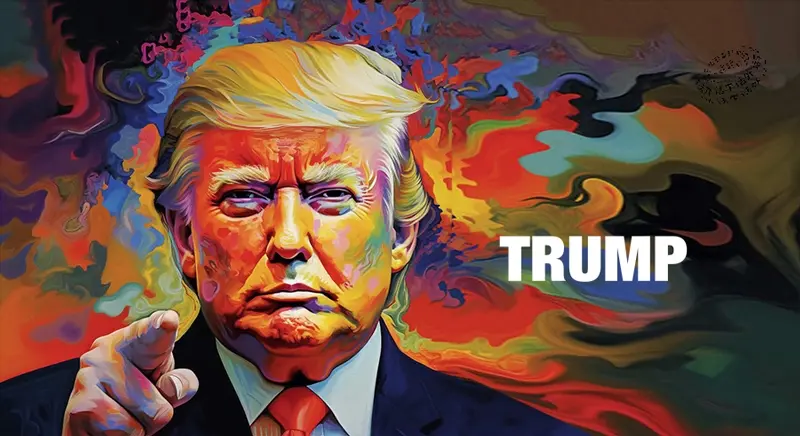Bitcoin continues to create historical highs. Is it a bull market trap or is a crazy bull market about to arrive?

Cover Design | Senka
Source | Talking Li and Outside
Bitcoin has finally broken through $80,000, currently sitting at $81,300 at the time of writing, with an overall increase of 30% over the past month. As shown in the figure below. Many had previously expected that this bull market would see Bitcoin break through $80,000, but no one anticipated that this result would come so quickly.
In recent days, I have noticed that discussions among my peers in the group have become very active again, with hundreds of messages being exchanged daily. Many members have shared their insights and expressed their views on the market, which I have greatly benefited from.
Here, I would like to share an interesting piece of history. I remember that in July 2023, when I decided to create a mutual aid group, it wasn't until the end of July that the first member joined me. By October of the same year, only 9 members had joined the group over the course of 4 months.
However, starting in November 2023, the number of people in the group began to increase rapidly, reaching over 200 members in just 2 months. If you compare this with the price trend of Bitcoin during that period, you will find that it coincided with a market uptrend. Then, starting in April 2024, the number of new members joining the group began to decline again, stabilizing within a relatively fixed range.
I remember that some members jokingly said that the group's activity level could serve as a market reference indicator. This is actually quite an interesting notion; from a certain perspective, it does seem to provide a direct auxiliary reference for market sentiment.
At this stage, the market has become very optimistic, with many people filled with expectations for the upcoming market trends, believing that the altcoin season has already begun. However, there are also those who hold the opposite view, believing that people are currently facing another bull market trap. In other words, the current market seems to have split into two opposing viewpoints:
One group believes that Trump's ascension will continue to stimulate a rapid rise in the crypto market.
The other group believes that people are currently (or soon will be) falling into a new round of bull market traps.
As the saying goes, "there are reasons for both sides," it seems that each viewpoint can present its own evidence. So, which direction will the market lean towards next? In this issue, we will continue to attempt some analysis and discussion:
1. Some altcoins are starting to go crazy
In the past two weeks, the BTC.D (BTC Dominance) indicator has only decreased by about 1%, from 60% to 50%, but some altcoins have already started to surge, with tokens like SUI and DRIFT reaching new record prices. As shown in the figure below.
On the surface, it seems that Trump's victory in the upcoming U.S. election has effectively stimulated this optimistic sentiment in the market, prompting some major players (institutions/market makers, etc.) to push up the prices of certain altcoins as Bitcoin continues to break historical highs. Perhaps, with the Fed's further interest rate cuts expected in the future, and with favorable macro conditions, this growth may continue for a while as new liquidity floods into the market.
2. Changes in BTC ETF fund inflows
So far, this bull market has primarily been driven by ETFs. Since the ETF was officially approved and launched this year, it has attracted a significant amount of new capital inflow, subsequently driving Bitcoin's price to new historical highs. However, starting around March of this year, the total funds in ETFs began to show a net outflow, causing market sentiment to decline. In contrast, recently, there has been a significant inflow of funds into BTC ETFs. As shown in the figure below.
Taking the last trading week as an example, the net inflow of Bitcoin spot ETFs reached $1.63 billion in a single week, with a record high net inflow of funds on November 7. Among them, the Bitcoin spot ETF with the highest net inflow was BlackRock's ETF IBIT, with a weekly net inflow of $1.25 billion. The second was Fidelity's ETF FBTC, with a weekly net inflow of $295 million.
ETF inflows serve as one of the important sentiment indicators. The logic here is quite clear, and with Trump's ascension, the political support for crypto in the U.S. is expected to strengthen, which may further increase the likelihood of traditional financial institutions/whales allocating funds to crypto assets. Currently, BTC ETFs are the most convenient channel for traditional funds to invest in crypto. Moreover, even for ordinary U.S. stock investors, BTC ETFs will become a very attractive asset type under Trump's endorsement.
3. Increased market liquidation intensity
As of the time of writing, the total liquidation amount across the network in the past 24 hours reached $683 million, with 214,459 people liquidated, including over $320 million in long liquidations and over $360 million in short liquidations, resulting in a double whammy for both sides. As shown in the figure below.
Many traders may primarily rely on technical analysis for their operations, but in the face of short-term market volatility, a large number of liquidations can occur. If a major bull market is to begin or continue, it will need to be accompanied by high-intensity liquidations and reshuffling before a more significant upward surge can happen.
We anticipate that the market may experience larger-scale liquidations in the coming days, so it is important to be aware of short-term risks, especially for those who have leveraged positions.
4. Geopolitical instability may persist
In recent days, it seems that most of the news people are seeing is positive, with various institutional analysts making bold predictions, such as:
Economist and trader Alex Krüger says: Bitcoin's target price by the end of the year is $90,000.
Well-known analyst Markus Thielen says: Bitcoin's price may break $100,000 by January 27, 2025, and reach a target of about $140,000 by April 29, 2025.
Standard Chartered analyst Geoff Kendrick says: BTC will rise to $125,000 by the end of the year.
Even well-known crypto KOL PlanB says: BTC is expected to reach $1 million by the end of 2025 (as a top KOL during the last bull market, I personally think PlanB's prediction is a bit exaggerated; Bitcoin may reach $1 million in the future, but it won't happen next year).
And so on…
However, we cannot ignore the fact that there are still some unstable factors in the current geopolitical landscape. The various positive news that the major players are showing you are actively pushed to the forefront, but with the rapid price increase, it is also possible that the major players will continue to use geopolitical events to create some negative news to test the market.
If the major players want to make a final violent upward move, they will definitely continue to conduct various necessary tests to assess whether people are ready to pour funds into the peak as buyers. If the tests are unsuccessful and liquidity still does not meet the expectations of the major players, then the market may inevitably enter a new round of correction.
In summary, we have only organized and discussed some phenomena we have recently observed. A bear market does not declare a bottom, and a bull market does not declare a top; anyone's so-called predictions about the market (including Talking Li and Outside) can only be seen as speculative behavior. For ordinary investors, our advice is to always maintain a respectful attitude towards the market, neither fully believing that some analysts are saying the bull market has just begun, nor fully believing that some analysts are saying the bull market is about to end. The key thinking logic should still be based on your own risk preferences and position management situation to make comprehensive considerations and decisions. For example, for those who have a Bitcoin holding cost of less than $20,000 in this cycle, we have actually come quite far at this stage.
I remember we mentioned in previous articles that if your average holding cost for Bitcoin during this bull market is below $40,000, once Bitcoin breaks $80,000, if you are worried and afraid of a potential new correction, you might consider starting to reduce your position in batches. The specific reduction ratio can be allocated according to your risk preference and market expectations, for example, reducing 10% of your position at $80,000, and then reducing another 10-20% at $85,000… and so on. However, in the actual operation process, you should not only focus on the price but also consider K-line indicators, on-chain data indicators, macroeconomic indicators, and other dimensions (or dimensions you personally prefer, such as the group activity level mentioned at the beginning of this article) to assist in your assessment.
As for altcoins, if you are not afraid of the potential corrections ahead, you can boldly buy now (but also control your position, preferably operate in batches and avoid going all in) or wait for a correction to buy those projects you are very optimistic about. From a theoretical and data perspective, altcoins have not yet reached the point of large-scale explosion. However, if you are not stable in your mindset or are easily afraid of losing, then any operation you make now is a 50-50 probability game for you.
Looking ahead, the overall trend of the market is likely to continue to rise (while also being aware of the correction risks in the coming days), but this bullish trend may not last long. Whether you can achieve your profit targets before this bull market ends will depend on your operations in the next six months. It is advisable to focus on the market opportunities before January next year (when Trump officially takes office as president); perhaps Bitcoin really has a chance to challenge the $100,000 mark. As for the anticipated new round of altcoin season, I cannot accurately judge or predict the specific timing, but I will continue to make a blind guess that it may occur in the first or second quarter of next year (when geopolitical issues may further ease, coupled with the Fed's continued interest rate cut expectations). However, it is unlikely to see a comprehensive altcoin season like the last bull market.
In the later stages of a bull market, the market will be filled with various tempting opportunities and FOMO emotions, but for retail investors like us, it often means greater challenges. I wish everyone good luck.









